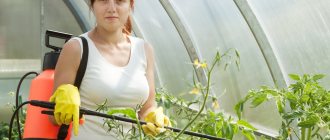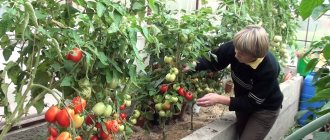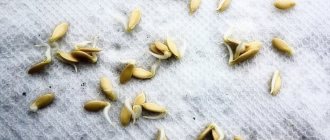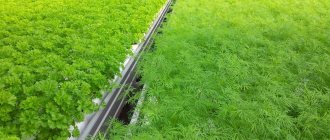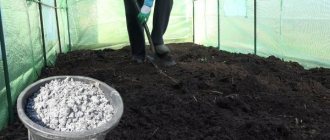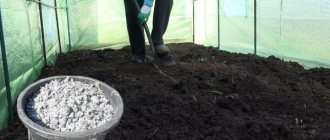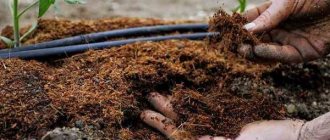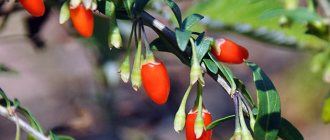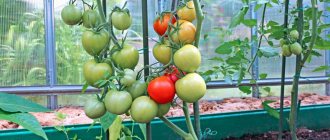Author: Elena N. https://floristics.info/ru/index.php?option=com_contact&view=contact&id=19 Category: Garden plants Published: March 12, 2019Last edits: January 06, 2021
Many gardeners love small cherry tomatoes: small but tasty, they are used for making salads, for pickling, and for decorating dishes. Cherries are an ingredient in some diets. In addition, growing these small tomatoes will not require heroic efforts on your part - cherry tomatoes are not capricious. However, this variety of tomatoes also has its own characteristics and requirements. That's what we'll talk about today.
Cherry varieties for growing in a summer cottage and their photos
that are not afraid of temperature fluctuations have been bred for cultivation in open ground or in a greenhouse . These are most often indeterminate species, growing up to 2.5-3 m.
Most popular:
- Barberry – up to 50 fruits can ripen in a cluster;
- Zlato - resistant to major diseases, high-yielding;
- "Dance with the Smurfs" - has a purple color;
- “Kira F1” is a very early ripening hybrid, the fruits are bright orange;
- “Orange grapes” - the fruit is saturated with carotene, has an orange color, and can be stored fresh for a long time.
There are a great variety of varieties for greenhouses and open ground; everyone will find among them one that suits their taste.
You can visually familiarize yourself with some of the varieties listed above in the photo below:
Photo gallery
The photo shows cherry tomatoes with fruits of different colors.
Cherry tomatoes with black fruits (Black Cherry variety)
Cherry tomatoes with red fruits (Monetka variety)
Cherry tomatoes with yellow fruits (Yellow Cherry variety)
Planting and growing seedlings
The process of growing first seedlings and then adult plants is not much different from caring for ordinary tomatoes. Small nuances concerning cherry tomatoes do not complicate this process at all.
When to plant seedlings?
sow seeds for seedlings in early April ; they will be planted in open ground in the middle or at the end of May.
Substrate preparation
The yield of an adult plant largely depends on the quality of the land in which the seedlings are grown. The soil should be loose and fertile . A mixture of humus, sawdust and peat works well. The soil is fertilized (can be mixed with manure) and disinfected with a solution of potassium permanganate heated to 70°. After this, it sits for two to three days.
Planting seedlings
The container for seedlings must have a side height of at least 15 cm so that there is room for the formation of the root system. Prepared, well-moistened soil is poured onto the bottom. Grooves are made in it, into which seeds are planted to a depth of 3 cm . If seeds of different varieties are planted, a separate container is used for each.
Illumination and temperature
The seedlings must be kept in a bright place and be sure to extend the daylight hours for them to at least 14 hours. To germinate seeds, you need a fairly high temperature - up to 30°. Therefore, the box or container with the sowing is placed closer to the heating devices until the seeds hatch. The top of the nursery is covered with film or glass.
Further cultivation of seedlings can take place at a temperature of 20-24°. If it drops to 16° and below, the fruit may not set.
Dive
is mandatory for cherry tomatoes . This species does not tolerate crowding and therefore the seedling bushes must be planted in separate pots. Picking is also needed to trim the roots. They are shortened by about a third. This operation allows the bush to grow a powerful root system.
After diving, the planted bushes can be fertilized with sodium humate (1 g per 2 liters of water).
Cherry seedlings are planted when 4-6 full leaves appear on the sprout. Care, both before and after diving, consists of regular watering, fertilizing every 10 days and loosening the soil.
Strong, high-quality seedlings must have a thick stem up to 30 cm high and at least 8 leaves . Its age at the time of disembarkation should be 60-65 days.
History of appearance
Today, cherry tomatoes are wildly popular, but until 1980 little was known about them. Scientists were able to determine that the original varieties appeared in the Andes; over time, the inhabitants of what is now Mexico learned to grow this crop.
The first tomato trees grew in the wild in small isolated groups, but in the 15th century, on the territory of modern America, Europeans learned to grow tomatoes of different tastes and with different sizes of fruits. These included cherry tomatoes.
To this day, no one knows who brought cherry tomatoes from America to Europe. Many historians are inclined to believe that these were representatives of Columbus's expedition. The first mentions in European works date back to 1623.
Two places immediately laid claim to the harvest of small tomatoes in Europe: Israel and the Greek island of Santorini. The opinions of scientists are divided; some believe that tomatoes could not have been brought from America, but were bred by breeders from Israel. Others claim that the island of Santorini is an excellent option for growing cherry tomatoes and is where the plant originated.
Despite this, historians agree on one thing - until 1980, few people knew about the plant, and tomatoes were grown locally in various European countries. The development of cherry tomatoes began with a wealthy realtor in England, who dreamed of filling all his stores with tasty, juicy, and most importantly, presentable tomatoes.
Scientists in Israel received an order from him and began to improve cherry tomatoes. They managed to make the fruits sweeter. We figured out how best to store tomatoes and created special methods for a more organized process of growing cherry tomatoes. Miniature tomatoes immediately gained popularity among vegetable lovers, and are still used today.
Landing in the ground
In the middle zone and in the northern regions, it is better to grow cherry tomatoes in greenhouses so that the ambient temperature does not fall below 16°. Before planting, seedlings are hardened off for one to two weeks.
Boxes with seedlings are placed outside for the day. The day before planting, they stop watering it.
Before planting seedlings, the bed needs to be prepared. If groundwater is close to the soil surface, it is better to raise the bed so that there is no excess moisture.
How to plant correctly?
The soil is loosened for good air and water permeability. Make holes in the ground at least 10 cm deep . Cherry tomatoes should not be planted closer than 50 cm from each other. The greater the distance between the bushes, the better the plant will bear fruit.
Transplantation of seedlings is carried out by transshipment, together with a ball of earth, to avoid damage to the roots. The hole is watered and buried.
You can clearly see how tomato planting occurs in the video below:
Where are tomatoes used?
The use of cherry tomatoes in the diet helps the lymphatic and circulatory systems return to normal. To prevent cancer, delicious tomato fruits are included in the menu. Throughout the summer you can enjoy ripened tomatoes. Children especially love them.
Restaurateurs have long noticed that there is no better way to decorate dishes than cherry tomatoes. Tomatoes are either cut in half or placed whole on dishes with salads, meat, and fish. Tomatoes go well with rice, potatoes, and legumes.
Housewives pickle and salt small fruits for the winter. Dried vegetables are considered a tasty preparation. They are kept in a ventilated area, dry and warm, without direct sunlight. The dried fruits are placed in jars and filled with vegetable oil.
Care
For tall varieties, a vertical support is required , to which the whip is tied as it grows. Stepping is carried out if many additional shoots grow. Some varieties require it.
When pinching, do not confuse a real leaf with a shoot. If you cut off the leaves, this will affect the fruiting of the bush.
Like all tomatoes, cherry tomatoes love airing; this helps pollination and prevents moist air from stagnating with unwanted microorganisms.
Watering and fertilizing
Cherry tomatoes like daily moderate watering . If this is not done, brown cracks will appear on the fruits. As a result of excessive watering, they will become watery and may also crack. Watering is done with warm water.
Tomatoes love complex mineral fertilizers containing not only phosphorus and potassium, but also modybdenum, zinc, iron, magranium, selenium and cobalt. It is difficult to make such a mixture on your own.
There is a wide range of such fertilizers on sale. The most commonly used are Agricola and Effecton . Experts recommend the Kemira as the most balanced in composition.
Tomatoes are fed once a week after transplanting into the ground. During the formation of ovaries, ammonium nitrate with the addition of wood ash is added.
If the bushes begin to grow, but the fruits do not ripen, then it is necessary to reduce or temporarily eliminate fertilizing with nitrogen fertilizers.
If you see white areas of pulp in the middle of a ripe fruit, it means that the tomatoes do not have enough nutrition.
There is a need to feed them with potassium sulfate .
Fertilizing must be combined with watering.
Working with soil
It is advisable to mulch the soil under cherry bushes with sawdust, straw, manure or agricultural canvas. This will prevent the fruits from coming into contact with the ground and will help avoid their rotting and infection with fungal diseases. In addition, this will protect the soil from overheating.
Cherry tomatoes require regular loosening and weeding.
Gardeners often use a simple technique to prevent tomato diseases. They are grown in metal buckets, which various pests do not like. Buckets can be dug into the ground, or simply placed in a garden bed or greenhouse.
Seed treatment before sowing
To grow cherry tomato seedlings at home and get the maximum number of seedlings before sowing, the seeds must be treated. This treatment increases the resistance of future seedlings to various diseases and makes them more resilient. From the proposed methods, you need to choose only a few, process the seeds, and only then plant them in the ground.
Seed treatment methods
- The seeds are placed in a 3% saline solution. All floating seeds are discarded.
- Fill a thermos with hot water (up to 50°C). The seeds are placed in a fabric bag and placed in water for 20-30 minutes. After this time, the bag is immediately transferred to a container with cold water to cool.
- Make a nutrient solution and soak the seeds in it. At home, such a solution can be made from the following ingredients: aloe juice, honey, wood ash solution. You can use nutritional formulas from the store.
- The seeds are soaked in various growth stimulants. These can be: “NV-101”, “Epin”, Energen, “Zircon”, Immunocytophyte, Succinic acid.
- Bubbling. The seeds are processed in oxygenated water. The seeds are placed in a jar, filled with water, and the hose of the aquarium compressor is lowered into it.
- Hardening of seeds. To do this, they are placed in water at a temperature of 20-25°C for twelve hours, and then in water at 2-3°C for another twelve hours. Repeat several times.
- Before planting in the ground, the seeds are germinated using a damp cloth (you can use cotton wool).
Ripening and harvesting
The ripening time of cherry tomatoes depends on the early maturity of the variety. They are able to bear fruit until the temperature drops below 8°. Usually the fruits are harvested before the end of September.
Cherries are loved by gardeners because their fruits ripen almost simultaneously and are of the same size. It is not recommended to pick tomatoes from the bunch until the last of them is ripe . The most convenient way to collect tomatoes is with brushes.
Choosing a place in the garden
For cherry tomatoes, it is important to choose a suitable place in the garden. This will directly affect the growth of the plant and its fertility. The selected area should be well lit and warmed by the sun; it is important to take into account the absence of drafts.
Advice! Cherries grow better if onions, radishes, beets, carrots, turnips or cabbage grew in this place last season.
If the predecessors of these tomatoes were other varieties of tomatoes, peppers, physalis, potatoes or eggplants, it is better to choose another site.
In addition, the soil must be prepared in advance. This culture takes all the nutrients from the earth, depleting it. You need to start preparing in the fall; the area is dug up and organic matter is added to the soil (humus is added). In spring, the beds need to be loosened well to 10-12 cm and nitrogen fertilizers added to the soil.
Description
Cherry is a type of tomato that is distinguished by its small fruit size. The weight of tomatoes ranges from 15 to 30 g. A tomato cluster is decorated with 15-20 berries. Outwardly they look like cherries, that’s why they are called cherry. Tomato Shape:
- elongated;
- round;
- drop-shaped.
Cherry tomatoes
The color palette is amazing in shades.
Cherry tomatoes are characterized by a rich and sweet taste. The original appearance makes Cherry tomatoes a table decoration.
Peru and South America are the birthplace of the tomato variety. Today Cherry is grown everywhere:
- on the balcony;
- in open and protected ground;
- in pots.
Window sill equipment
Experienced vegetable growers know how to grow cherry tomatoes at home. Tomatoes are considered rather fastidious plants that require the creation of certain favorable conditions for good development and fruiting. It is worth making every effort to organize a place for them. The choice of position is of great importance: the most illuminated window sill should be adapted for placing containers with tomatoes. A window facing the south, south-east or south-west is best suited, then the tomatoes will be able to receive sufficient light throughout the year. Daylight hours for tomatoes should last at least 12 hours. Growing cherry tomatoes on the balcony also requires compliance with certain rules and taking into account the peculiarities of cultivation and care.
Secrets of vegetable growers
When growing cherry tomatoes, you can use the advice of experienced gardeners who recommend:
- monitor the optimal humidity level so that excess moisture does not push the plant to expel its stepsons;
- reduce watering in inclement weather;
- help self-pollinating shoots with a brush;
- to speed up the rooting of cuttings, add a little flower fertilizer to the water;
- Replant shoots that have taken root again at the beginning of summer to prolong fruiting.
German gardeners, in conditions of lack of light, use an interesting method: they restrain the growth of seedlings by stroking the tops of plants with a brush in order to damage the hairs and slow down the upward growth of the bush. Then he begins to send out side shoots.
You can learn some more growing tips from an expert in the video
Miniature tomatoes are considered a great alternative to traditional tomato varieties. Their taste is more piquant than ordinary ones, due to the content of more sugar in them, at the same time, the calorie content does not exceed the norm for dietary products, which allows their use by those on a diet. Growing these tomatoes on a window or balcony is not too difficult. Compliance with the basic rules of planting and care will allow you to obtain a harvest within several months and in an unusual season. In addition, they can become a wonderful decorative decoration for a window sill or balcony.
Types of cherry
The name for tomato was not invented by chance. It literally translates as “cherry”. But this does not mean that all fruits are small, round and red. There are thousands of different types of these tomatoes. They are oval, oblong, green, and yellow. The characteristics of their breeding are different, depending on the regions grown and the type of variety.
Cherries grown in the garden mostly have tall bushes of two meters or more.
According to weight criteria, they are divided into two types:
- Berry. The tiniest weighing from 4 grams. They have the sweet taste of berries and tomatoes at the same time. They are grown mainly for salads or desserts.
- Cocktails They weigh from 20 to 50 grams. It tastes like sweet and sour tomatoes, but there are exclusive varieties.
The most famous cherry varieties:
- Ocean.
- Elf.
- White nutmeg.
- Cherry blossoms.
- Green grapes.
- Balcony miracle.
- Sweet cherry.
- Strawberry.
- Fingers.
Small varieties are chosen for their compactness, sugary taste, and rich taste. You need to learn how to plant them correctly.
